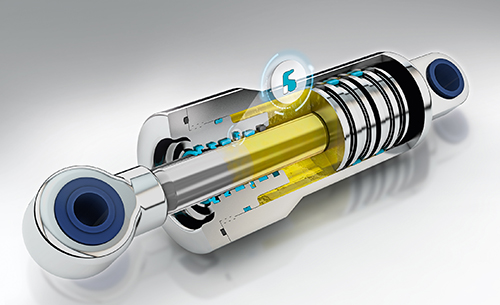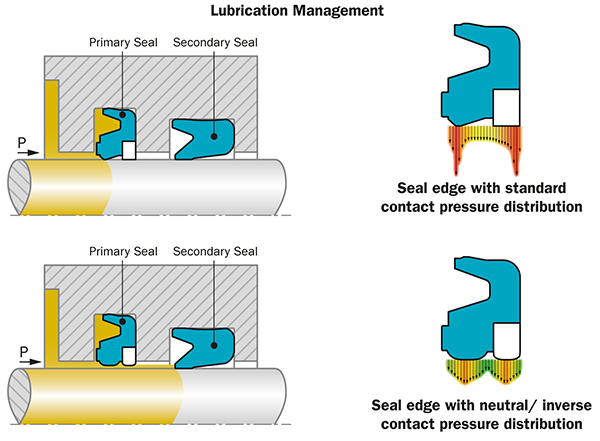
Multiple seals, lubrication, and pressure fluid need to work together as a team.
The concept of lubrication management looks at adjusting the lubrication conditions of all single sealing elements within a sealing system to ensure that the load on each element can be reduced and performance around friction-wear-lifetime can be optimized. Constantly increasing performance requirements for industrial equipment and the reciprocating movements involved require this.
“When properly engineering a sealing system, all elements within the sealing system—the seals and lubrication, or pressure fluid, in particular—must work together as a team,” Holger Jordan, Segment Manager, Fluid Power Europe for Trelleborg Sealing Solutions said. “The pressure fluid can be seen as both a challenging element and a supporting team member. The pressure is the load and challenge while the fluid in the contact area between seal and counter surface, is the supporting partner in reducing friction and wear by lubrication.”
Optimizing performance of primary and secondary industrial seals
Jordan said that the best arrangement in demanding fluid power sealing applications is a primary and a secondary seal.
“The primary seal does the sealing job for as long as possible and the secondary seal is the redundancy and is there when it is needed” he said. “The challenge for this secondary sealing element is length of life under dry running conditions. The more effective the primary seal is at sealing in lubricant to the hydraulic system, the drier the running conditions of the secondary seal. Starvation of lubrication can lead to wear issues that come in to play in the case of a needed redundancy.”
In order to create the greatest performance of the primary and secondary seal arrangement, lubrication management can balance the risk of leakage of the lubricant with performance of the primary seal along with extended life of the secondary seal.
“This is achieved by allowing a better, thicker oil film under the most pressure loaded first sealing element to reduce the load on that seal. The fluid film volume transferring past the primary seal is then controlled, normally with an integrated check valve in the primary seal, to the contact area of the secondary seal to the counter surface,” he said.
Lubrication management principles
The lubrication management principles should be tested to determine the optimum method of control in terms of wear inhibitors and lubrication type.
“For instance, we have tested the reduction in interference using a polyurethane Buffer Seal and found that compression set behavior was reduced by almost 50% simply with the additional of a wear inhibitor and partner lubrication. Overall, reduction ratios in friction of about 50% were achieved and taking the whole sealing system into consideration, the reduction can even be up to 70%,” Jordan said.
“Establishing that friction and wear are significantly influenced by lubrication management shows that the added value for the customer is in improved wear resistance and performance of the secondary seal in need of redundancy. This satisfies many of the demand-driven trends, which are currently under discussion in the world of fluid power.”

The top view – standard sealing system- shows high contact pressure with minimal oil lubrication and thus high wear and friction. The bottom views is a lubrication management system, which demonstrates how low contact pressure with effective oil lubrication offers low wear and friction on the primary and secondary seals.
Trends include reduction of size and weight of hydraulic systems leading to an elevation in pressure and increases in speeds of hydraulic applications which in turn, means that polyurethane seals reach material limits. The sealing system in both cases can be improved through lubrication management.
Jordan noted that other issues include the coating of counter surfaces in hydraulic applications.
“These are often decided for technical reasons without any consideration of the sealing system, but can be a limiting factor in terms of the service life of seals within an application,” he said.
“Also, spray coatings, such as High Velocity Oxygen Fuel (HVOF) coating, differ a lot compared to standard galvanic processes such as hard chrome plating. The big difference in seal performance in view of a service time is related to the completely different surface topography of the differing coating technologies,” he said.
Roughness characteristics such as embedded holes in the counter surface are also a general challenge for sealing systems, as hole edges on the contact area can act like a knife, cutting the seal as it passes the holes, causing abrasive wear on the seals and wearing them out rapidly.
The benefit of establishing effective hydraulic lubrication management
The cost related to modifying coatings or post processing to prevent wear can play a significant role in competitiveness on the international market. Implementing lubrication management on the sealing system can give more freedom in discussion of limits for seal performance in relation to roughness specifications, potentially lowering total cost of hydraulic systems.
In conclusion, Jordan said, “Teamwork is obviously important between both seal and lubrication developers and the end user, for optimizing the performance of sealing systems in fluid power applications. This ensures the development of the most effective system in terms of operation, wear resistance and limitation of leakage.”
By Joyce Laird
The post How can hydraulic lubrication management optimize seal performance? appeared first on Sealing & Contamination Control Tips.
Filed Under: Sealing